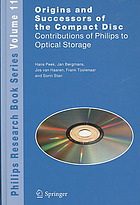

Most ebook files are in PDF format, so you can easily read them using various software such as Foxit Reader or directly on the Google Chrome browser.
Some ebook files are released by publishers in other formats such as .awz, .mobi, .epub, .fb2, etc. You may need to install specific software to read these formats on mobile/PC, such as Calibre.
Please read the tutorial at this link: https://ebookbell.com/faq
We offer FREE conversion to the popular formats you request; however, this may take some time. Therefore, right after payment, please email us, and we will try to provide the service as quickly as possible.
For some exceptional file formats or broken links (if any), please refrain from opening any disputes. Instead, email us first, and we will try to assist within a maximum of 6 hours.
EbookBell Team

0.0
0 reviewsIn March 1979, a prototype of a ‘Compact Disc (CD) digital audio system’ was publicly presented and demonstrated to an audience of about 300 journalists at Philips in Eindhoven, The Netherlands. This milestone effectively marked the beginning of the digital entertainment era. In the years to follow, the CD-audio system became an astonishing worldwide success, and was followed by successful derivatives such as CD-ROM, CD-RW, DVD, and recently Blu-ray Disc. Today, around the thirtieth anniversary of the milestone, it is taken for granted that media content is stored and distributed digitally, and the analog era seems long gone. This book retraces the origins of the CD system and the subsequent evolution of digital optical storage, with a focus on the contributions of Philips to this field. The book contains perspectives on the history and evolution of optical storage, along with reproductions of key technical contributions of Philips to the field.